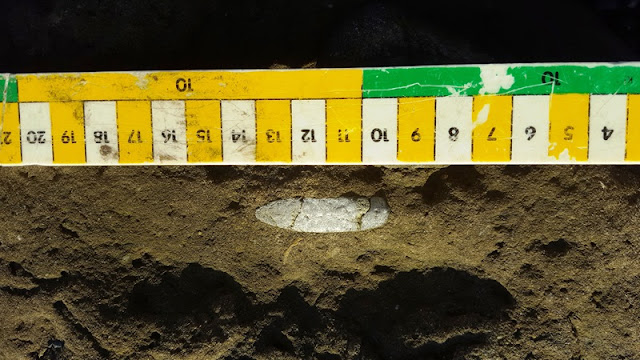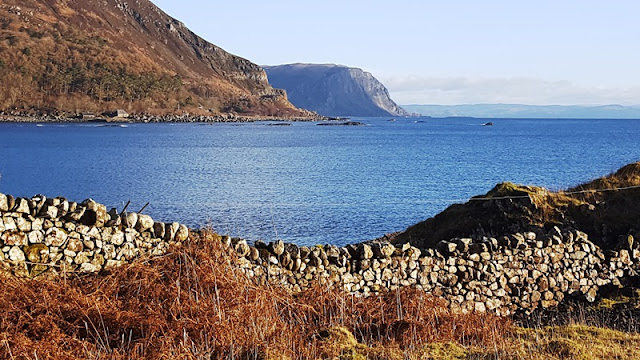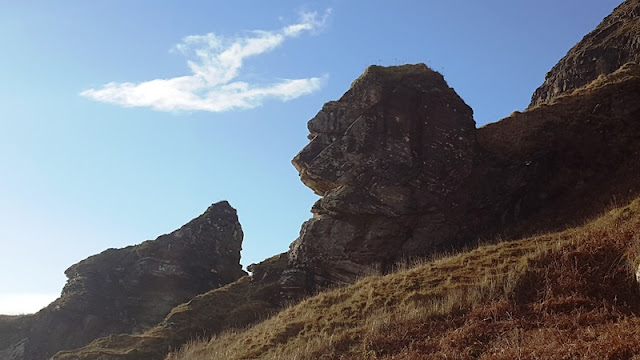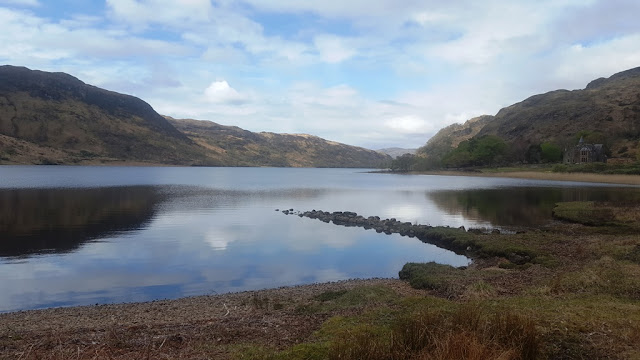Carsaig - a trip to Rudh a'Chromain, 28th Dec 2017
The weather forecast was good for the 28th so I decided to have a look at the Carsaig area. During the VMSG field trip in September, I wasnt able to make this particular day due to other commitments so it was a case of catching up. Carsaig is a favourite are of mine - I first visited it as an undergraduate from St Andrews in November 1979 - Dr. Colin Donaldson led the trip. I have always enjoyed going back there - there is simply so much geology to see in one small area. I reckon it is the best location in Mull for geology trips - a lot to see in a small area. And a great mixture of sedimentary as well as igneous. You really get to see and appreciate how the later Palaeogene volcanic rocks have been intruded and erupted onto the earlier (Jurassic and Cretaceous) landscape, Here are some pictures and further details!
View from the old pier looking west towards the cliffs.
View from the shore, again looking over to the cliffs.Cliffs are mainly Palaogene lavas and minor intrucions with Jurassic and Cretaceous sedimentary rocks near the base and on the shore
Lots of fossils to be found on the shore - this is a belemnite - ruler for scale
The fossil Gryphaea can be found in abundance:
Moving on to the west side of the bay:
Many minor intrusions cut across the sedimentary rocks on the shore. Most of these stand up as they resist the weathering better than the sedimentary rocks. This one is a small dyke at the west side of the bay
In the same area, this is a small sill cutting the same rocks.
A bit further along is a composite sill - felsite interior with mafic margins. The sill has a columnar structure to it. It is easy to find - a wall and a fence have been built on it. The sill shows very obvious flow banding.
Two views of the composite sill at Aird Ghlas. Not visible in this picture, but clearly visible at very low tide is a large "canoe" like structure - it may be a large xenolith. Only saw it once before - you do really need a very low tide to get out that far:
The strange looking structure at the furthest out point of the sill
The view from the sill back towards Loch Buie and Laggan is very nice:
The cliffs near Aird Ghlas have some great exposures of sandstone:
Looking at it a bit closer, large round concretions can be seen. Honeycomb weathering is very obvious as well. The sandstone is well seen above a scree fan which is a bit unstable and seems to have a steady stream of material running down on to it.
On the shore,fallen blocks of the sedimentary rocks can be found, many of these contain fossils:
Fossils galore in the fallen blocks!
Moving on westwards past Aird Ghlas, the going is a bit easier as you approach the Nuns Cave and Rudh a' Chromain.
Honeycomb weathering in concretions near theNuns Cave
One of the local residents and a shadow selfie! He was very close!
The Nuns Cave - very wet at the entrance
The composite sill of Rudh a'Chromain is just beyond the Nuns Cave.
On the sill at Rudh a'Chromain, looking back to the cliffs and the Nuns Pass. Palaeogene lavas in the cliffs, sandstone outcrops at the base
Standing on the rocky foreshore just east of Rudh a' Chromain, looking back towards Carsaig. Sandstones on the shore
The Sphynx rock - a sandstone outcrop that looks down onto Rudh a'Chromain
Interesting weathering of the sandstones on the shore
The view to the west from Rudh a'Chromain - Carsaig Arches are round the headland in the distance - still a long way to go!
The Rudh a'Chromain sill, part of the Loch Scridain Sill Complex is famous for being full of interesting xenoliths, some of which have been found to contain sapphire. Didnt find any this trip, but here's a nice example of a xenolith in the sill.
It was time to head back to Carsaig.Here are a few pictures from the walk back:
Cutting across the sandstone on the shore is this dyke, which at first glance looks like a sedimentary rock. The close up pick shows banding. Presumably (and I am not totally sure here) the appearance is due to weathering out of flow banding. It looks very similar to the surrounding sandstones.
Close up of the dyke rock
Approaching the composite sill at Aird Ghlas, the light from the sun going down was amazing.
So that was that - a great day visiting my favourite place in Mull to look at geology. And thats just the west side of the bay.The east side is possibly even more interesting! That can wait for another day and another blog entry!
View from the shore, again looking over to the cliffs.Cliffs are mainly Palaogene lavas and minor intrucions with Jurassic and Cretaceous sedimentary rocks near the base and on the shore
Lots of fossils to be found on the shore - this is a belemnite - ruler for scale
The fossil Gryphaea can be found in abundance:
Moving on to the west side of the bay:
Many minor intrusions cut across the sedimentary rocks on the shore. Most of these stand up as they resist the weathering better than the sedimentary rocks. This one is a small dyke at the west side of the bay
In the same area, this is a small sill cutting the same rocks.
A bit further along is a composite sill - felsite interior with mafic margins. The sill has a columnar structure to it. It is easy to find - a wall and a fence have been built on it. The sill shows very obvious flow banding.
Two views of the composite sill at Aird Ghlas. Not visible in this picture, but clearly visible at very low tide is a large "canoe" like structure - it may be a large xenolith. Only saw it once before - you do really need a very low tide to get out that far:
The strange looking structure at the furthest out point of the sill
The view from the sill back towards Loch Buie and Laggan is very nice:
The cliffs near Aird Ghlas have some great exposures of sandstone:
Looking at it a bit closer, large round concretions can be seen. Honeycomb weathering is very obvious as well. The sandstone is well seen above a scree fan which is a bit unstable and seems to have a steady stream of material running down on to it.
On the shore,fallen blocks of the sedimentary rocks can be found, many of these contain fossils:
Fossils galore in the fallen blocks!
Moving on westwards past Aird Ghlas, the going is a bit easier as you approach the Nuns Cave and Rudh a' Chromain.
Honeycomb weathering in concretions near theNuns Cave
One of the local residents and a shadow selfie! He was very close!
The composite sill of Rudh a'Chromain is just beyond the Nuns Cave.
On the sill at Rudh a'Chromain, looking back to the cliffs and the Nuns Pass. Palaeogene lavas in the cliffs, sandstone outcrops at the base
The Sphynx rock - a sandstone outcrop that looks down onto Rudh a'Chromain
Interesting weathering of the sandstones on the shore
The view to the west from Rudh a'Chromain - Carsaig Arches are round the headland in the distance - still a long way to go!
The Rudh a'Chromain sill, part of the Loch Scridain Sill Complex is famous for being full of interesting xenoliths, some of which have been found to contain sapphire. Didnt find any this trip, but here's a nice example of a xenolith in the sill.
It was time to head back to Carsaig.Here are a few pictures from the walk back:
Cutting across the sandstone on the shore is this dyke, which at first glance looks like a sedimentary rock. The close up pick shows banding. Presumably (and I am not totally sure here) the appearance is due to weathering out of flow banding. It looks very similar to the surrounding sandstones.
Rather a nice rainbow on the walk back
So that was that - a great day visiting my favourite place in Mull to look at geology. And thats just the west side of the bay.The east side is possibly even more interesting! That can wait for another day and another blog entry!






























Comments